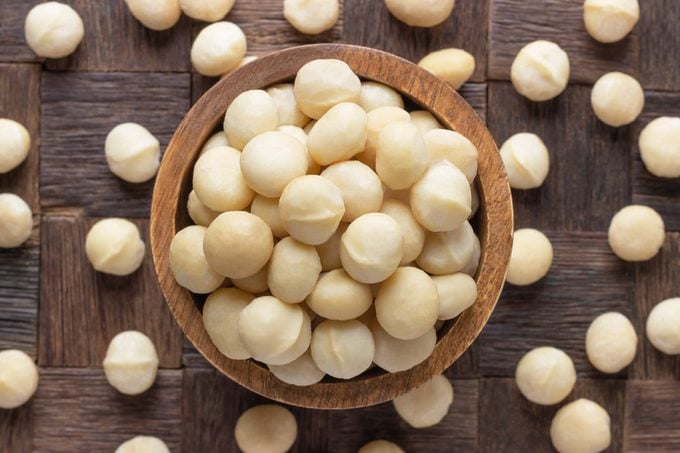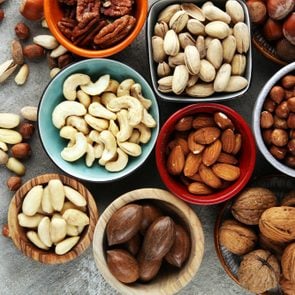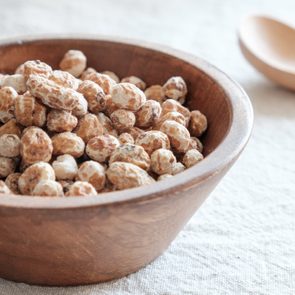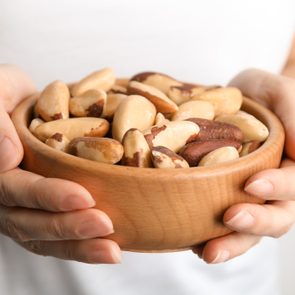Are Macadamia Nuts Good for You? Their Nutrition, Benefits, and More
Updated: Mar. 31, 2022
Here's what you need to know about macadamia nuts' nutrition, calories, carbs, and health benefits.
Macadamia nuts: Little gems packed with nutrients
Have you ever noticed macadamia nuts are sold in smaller quantities than other nuts? Per pound, they’re more expensive than other healthy nuts you eat. So, putting them in a smaller package is less of a sticker shock. Still, an eight-ounce bag of raw macadamia nuts is around $15 versus $5 for a same-size package of almonds.
Yet, these creamy and buttery nuts are enjoying a surge of popularity. Why? More people are eating plant-based, low-carb, and keto diets and have discovered these little gems are packed with nutrients.
“For individuals on a low-carb or ketogenic diet, this nut’s nutrient profile provides a high ratio of healthy fats to carbs,” says Kristina Comer, RD, a registered dietitian with UCHealth Integrative Medicine Center—Central Park, in Denver. “They are slightly lower in protein than almonds and pistachios, but still bring in a good source of fiber.”
Here’s what you need to know about macadamia nuts’ nutrition, health benefits, risks, and how to add them to your diet.
Where do macadamia nuts grow?
It might surprise you to know that while macadamia nuts are the signature crop of Hawaii, they didn’t get their start there. They actually originated in Australia, which still contributes more than 30 percent of the global crop. South Africa, Kenya, Columbia, Brazil, Costa Rica, and Guatemala also grow macadamia nuts.
How do macadamia nuts grow?
Like other tree nuts, macadamia nuts take their sweet time growing. It takes about five to seven years before nuts start growing. Full production takes 12 to 15 years. By then, the trees are 40 to 50 feet tall and will continue to turn out Macadamia nuts for 100 years or more.
A hard shell houses a single sphere-shaped nut divided into two halves. They’re harvested just five to six times a year and mainly by hand, making the harvesting process time-consuming and likely why macadamia nuts are more expensive. (Here’s how to eat healthy on a budget.)

Macadamia nut nutrition
Here’s the noteworthy nutrition for one ounce (28 grams) of raw, unsalted macadamia nuts (about 10 to 12 nuts).
Calories: 204
Total Fat: 21 g
Protein: 2.3 g (4% DV)
Carbs: 4 g (1% DV)
Sugar: 1.3 g (33% DV)
Fiber: 2.5 g (10% DV)
Healthy fats in macadamia nuts
Macadamia nuts contain more fat than any other tree nut. But they shouldn’t be avoided or enjoyed only on special occasions. That fat in macadamia nuts primarily consists of good-for-you monounsaturated fatty acids.
“These fats have been linked with improving heart health and can lower your risk of heart disease and heart attacks,” says Comer.
Floating around in that monounsaturated fat is omega-7, otherwise known as palmitoleic acid. In fact, macadamia nuts rank the highest when it comes to palmitoleic acid, at 17 percent.
“Palmitoleic acid has been found to help with heart health, reducing your chances of high blood pressure and atherosclerosis,” a condition in which plaque builds up in your arteries, says Emily Holdorf, RD, a registered dietitian at Colgate University in Hamilton, New York. “It also can help support insulin sensitivity, by protecting against insulin resistance, and help reduce inflammation and swelling within the body.”
High levels of manganese
Manganese is one of the standout minerals in macadamia nuts. A serving contains more than half of what we need each day. But how does it benefit us? “This nutrient is important for metabolism, strong bones, reproduction, and a healthy immune system,” says Comer. (Also, check out these immune-boosting foods.)
Thiamine and copper
Thiamine, commonly known as B1, is another notable nutrient in macadamia nuts.
“Thiamine helps the body use carbohydrates as energy by turning them into glucose,” says Holdorf. “It also helps with brain and nerve function.”
Your body doesn’t store thiamine, so you need to eat foods such as macadamia nuts and other thiamine-rich foods like peas, oranges, bananas, and whole-grain breads.
Copper aids the immune system, bone health, and red and white blood cell production. Speaking of blood, copper launches iron to form hemoglobin, responsible for carrying oxygen throughout the body. Unlike thiamine, copper is stored in the body.
Macadamia nuts’ potential health benefits
Healthier skin
Macadamia nuts contain tocotrienols, a type of antioxidant. You might even see “macadamia oil” on the labels of antiaging skin creams and serums. Tocotrienols also help protect against oxidative stress due to sun exposure. People may want to steer clear of oxidative stress because it damages cells, DNA, and contributes to a host of serious health conditions.
Protects the brain
The palmitoleic acid in academia nuts is good for heart health, but it also has a side hustle—the brain. Palmitoleic acid is a major element of myelin, the fatty protective coating around brain neurons.
Neurons are the brain’s messengers, transporting information necessary for the body to function to nerve cells, gland cells, and muscles. Palmitoleic acid also protects your brain for the long haul, helping to fight off neurodegenerative diseases and mental disorders.
Promotes satiety
“A handful of these nuts each day can be a good way to incorporate plant-based protein, fat, and fiber, which helps promote satiety,” says Comer.
The challenge is to stop at a handful, which is about 1/4 cup. A whole cup of macadamia nuts would add up to about 1,000 calories.
“Keep in mind that nuts are calorically dense,” adds Comer. “If weight loss or weight maintenance is a goal, be mindful of portion sizes and try not to overdo it.”
Risks of eating macadamia nuts
Generally, macadamia nuts are safe for consumption. However, if you have a peanut allergy, you may also be allergic to tree nuts, which include macadamia nuts. If you have a peanut allergy, but are okay to consume tree nuts, be sure you’re aware of the risk of cross-contamination.
And if you do have an allergy to tree nuts, you’re more likely to be allergic to these nuts. (Beware of these easy-to-miss food allergy symptoms.)
What to look for when buying macadamia nuts
When you’re buying macadamia nuts, choose raw or dry-roasted, rather than nuts cooked in oil. Buying raw nuts allows you to soak them first.
“Soaking nuts of any kind helps your body better absorb the nutrients and increases their digestibility,” says Holdorf. “It also can improve the flavor of the nuts and improve blending if you are making nut milk at home.”
If you want roasted nuts, Comer recommends storing them in a dark canister to prevent oxidation and delay rancidity by blocking light.
You may also want to consider buying organic to avoid the herbicide atrazine. According to Comer, it is widely used in the U.S. but banned in several European countries. “It is currently being studied for its impact on animals, the water supply, and human health,” she says. (Here are the organic foods nutritionists don’t waste their money on.)
Tasty ways to eat macadamia nuts
The buttery-rich flavor of macadamia nuts are melt-in-your-mouth worthy on their own. But if you want to experiment with other tasty options, Comer and Holdorf have these suggestions:
- Top yogurt, oatmeal, or salads with chopped macadamia nuts
- Add them to homemade granola or energy bars
- Blend into homemade nut milk and nut butter
- Use finely chopped macadamia nuts as a coating for fish or chicken
- Dip nuts in dark chocolate or include in your favorite cookie recipe
Storage tips
Macadamia nuts, like Brazil nuts, pecans, and other nuts, can go bad quickly due to their fat content. Plus, the nutrition benefits take a nosedive. And because macadamia nuts have the highest amount of fat, they can go rancid even quicker.
“Storing nuts in the refrigerator or freezer in an airtight packaging can help prolong their shelf life,” says Comer.
Next, here’s what you need to know about tiger nuts.























